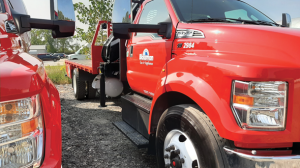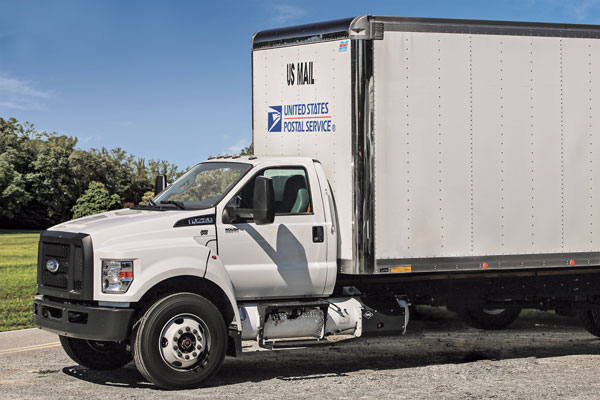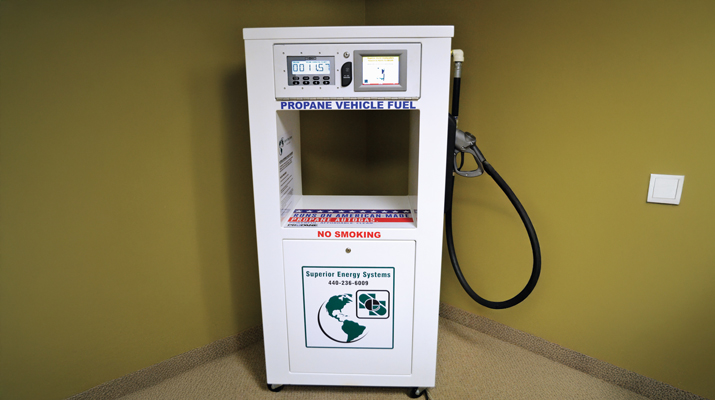Potential unleashed: Propane autogas market continues to evolve
Propane industry leaders are confident that autogas is burning a path to popularity, especially in the Class 3-7 vehicle market.

Blossman Gas utilizes
this Ford F-750 with a 6.8-liter V-10 engine. The company has 396 autogas vehicles in service across its fleet. (Photo courtesy of Blossman Gas)
“For fleets where range, performance and payload matter – delivery, food and beverage, paratransit and school bus – propane autogas delivers,” says Steve Whaley, director of autogas business development at the Propane Education & Research Council (PERC). “That’s where we shine.”
According to Whaley, the food and beverage delivery market noticed an upturn in propane usage as home food delivery skyrocketed during the COVID-19 pandemic. And the parcel package delivery market is witnessing an increase in propane usage as well, as 1,100 systems are using propane.
U.S. Postal Service contractors are using autogas now, too, as they’re saving 40 percent on fuel costs when compared to using diesel; these contractors have 70,000 of the agency’s 92,000 routes.
“More and more propane marketers are seeing these trends and understanding they have to use the fuel they’re delivering as a credible testimony,” he says.
Sweet spots
Aside from these trends in propane usage, Stuart Weidie, president of Alliance AutoGas, as well as president and CEO of Blossman Gas, has noticed another significant trend: The propane industry has a wide array of autogas options from which marketers and fleet customers can choose.
For example, Ford F-750s are used considerably for propane bobtails, while Chevy, Dodge and Ford service vehicles have become popular within the propane industry.
“These offerings, however, are the same as where we’re seeing success with commercial fleets,” Weidie says. “Blossman Gas is operating the same vehicles as the commercial fleets it’s trying to sell to, which has provided credibility for our fuel, autogas systems and autogas in general.”
He adds, “Propane is more affordable than traditional fleet fuels. And, in today’s climate, the spread between gasoline/diesel and propane is increasing, thereby creating momentum for our industry.”
Albert Venezio, CEO of Icom North America, agrees with Whaley’s sentiment, stressing that Class 3-7 vehicles are the “sweet spots” for autogas, as they’re perfect fits for centralized fleets, routes and fueling.
“The autogas market is moving toward a variety of vehicles, from box trucks, larger pickups and work trucks, to propane work trucks and bobtails, to school buses and shuttle buses, to DHL and UPS,” he says.
And the market is constantly evolving, too, according to the needs of the fleets they serve. After all, according to Weidie, autogas is one of the only alternative fuel solutions that enables customers to utilize their fleet vehicles for what they originally intended when they purchased them: work.
“Our fuel density offers a compact solution in your vehicle, unlike a CNG vehicle, in which the tank is occupying valuable real estate, or an electric vehicle, in which the payload capacity is reduced, due to the battery’s extra weight,” Weidie says. “The costs associated with diesel truck maintenance are becoming a big issue for many fleets. And they’re creating opportunities for a clean, cost-effective alternative fuel, such as propane autogas.”

U.S. Postal Service contractors, which run most of the agency’s routes, now use autogas. (Photo by Lisa McAbee)
Public perception of EVs
As a result of propane autogas’s cleanliness and cost-effectiveness, Weidie believes propane marketers should not be overly concerned about the widely discussed threat posed by the electric vehicle (EV) market, either. After all, the public perception of EVs is actually a larger threat than that of the vehicles themselves, especially when one considers the needs of commercial fleets, he says.
He also thinks EVs will primarily be used as personal vehicles over the next 20 years due to their limits on range and load. And their release in the marketplace is being delayed, too, as the raw materials required to create the vehicles’ batteries have led to supply issues.
“The propane industry should be working right now to change the public’s perception of autogas,” he adds. “Propane should be positioned as a viable alternative fuel that will positively change our climate, starting today.”
Whaley agrees that the propane autogas market’s greatest threat – publicly – is the perception about how EVs perform, adding that is what the market “battles the most.”
“Technologically, there’s not much threat at all, as autogas can run circles around EVs on every aspect, including vehicle pricing, energy cost-per-mile and lifecycle emissions reductions,” he says. “While EVs may be a good selection for light-duty consumer vehicle applications, other energy sources, like propane autogas, are better suited for medium- and heavy-duty truck applications, in which operational costs, payloads, performances and ranges matter greatly.”
According to Whaley, the incremental capital cost for a medium-duty propane autogas vehicle, relative to its gasoline or diesel counterpart, is 15 percent, on average. To compare, a similar, medium-duty EV is more than 250 percent.
“The artificial boosting of EVs must be countered, as some fleets are currently waiting for electric to be available for the vehicle classes they use,” Venezio says. “To counter this, the propane industry has to keep making the real, practical case for autogas, and be open about how it compares to electric. Organizations like PERC have been doing this, but the industry, as a whole, must do much more.”

Marketers that run their own vehicles on propane autogas provide credible testimony of the fuel’s quality to commercial customers that operate similar fleets. (Photo courtesy of Roush CleanTech)
Impact of renewable propane
Aside from countering the public’s perception of the EV market, the propane industry must also facilitate the production of renewable propane for the autogas market, according to Weidie.
“Not only will a renewable offering make our fuel appeal to a wider variety of businesses and policymakers, but renewable propane significantly benefits the environment as well,” he says. “In fact, renewable propane’s carbon intensity score is 14, compared to 39 for an electric vehicle, 78 for fossil propane and 86 for gasoline.”
He continues, “Without a renewable offering, our industry will lose a seat at the table for any future sustainable energy discussions, which are currently dominated by solar and wind.”
Likewise, Venezio believes renewable propane is a game-changer, adding that renewable propane can have a potentially significant impact on medium-duty and light-duty fleets, just as renewable natural gas has already had a considerable influence on fleets of heavy-duty Class 8 trucks.
“Autogas can then compete on an equal footing with electric,” he says. “Plus, autogas is real, practical and has a great ROI.”
Additionally, like conventional propane, renewable propane offers high power, portability and reliability, thereby adding even more positives to propane autogas – an already clean, powerful, low-carbon fuel that’s easy to use and store.
During the past two years, 9 million gallons of renewable propane – made from animal fats and oil, among other feedstocks – have been dispensed into vehicles, according to Whaley. However, within the next few years, 100 million gallons of renewable propane will likely be available; by 2030, that figure will rise to 300 million gallons, he adds.
“The common misperception is that, since propane is a fossil fuel, it’s similar to oil and coal. But propane, like natural gas, is not like these other fossil fuels. It is extremely clean,” he says. “With renewable propane, this misperception can end. If I want a seat at the decarbonization table, renewable propane will provide me that seat.”
He adds, “And once there, we can discuss the huge benefits of conventional propane over other alternatives, in addition to how renewable propane can take us further down the true path to zero emissions today – and decades down the road.”
Featured photo: Blossman Gas
















